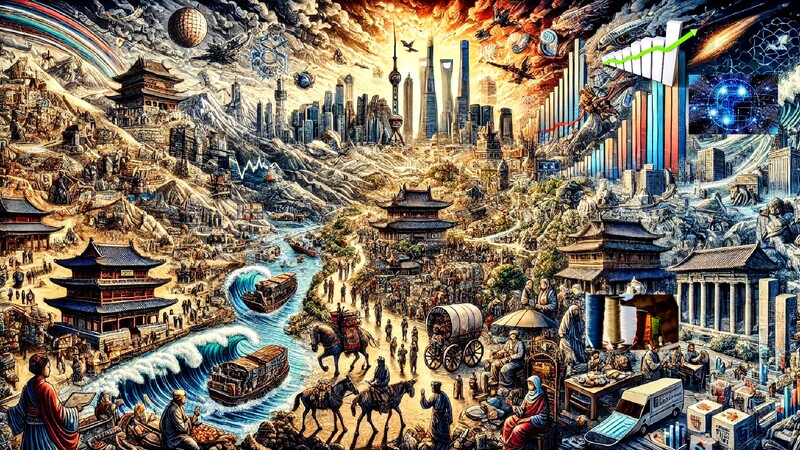Sgx And B3 Alliance: Brazilian Real Futures Launch In Asia...
Asia
Markets
The Singapore Exchange (SGX) has announced a strategic partnership with Brazil’s B3 exchange to launch futures contracts in the Brazilian real later this year, subject to regulatory approval. These futures contracts represent SGX’s initial venture into emerging market currencies beyond Asia.
Significance of the SGX-B3 Alliance
This collaboration leverages Singapore’s status as a premier financial hub in Asia to provide investors with innovative tools for hedging currency risk in Latin America. SGX, a leader in Asia’s derivatives market, is expanding through its alliance with B3 to meet the demand for Latin American market access.
Brazilian Economy and International Trade Dynamics
Brazil is a key player in global commerce with major exports such as iron ore, soybeans, and crude oil. Increasing economic interdependence between Asia and Latin America underscores the need for reliable currency risk management solutions, particularly for firms involved in intercontinental trade.
Benefits of Brazilian Real Futures in Asia
This initiative brings several advantages, including enabling Asian investors to trade Brazilian real futures during their local trading hours and reducing reliance on U.S. and European markets. It also strengthens risk management for firms by providing tools to hedge currency volatility and enhance financial certainty.
Boosting Trade and Investment Between Asia and Brazil Trade flows between Singapore and Brazil, valued at approximately $4 billion annually, include imports like crude oil and agricultural products and exports such as refined petroleum and electronic components. The introduction of futures contracts will foster economic relations and facilitate investment flows.
Challenges in Implementation
The success of this initiative relies on securing regulatory approval in Brazil and Singapore, which may delay implementation. Liquidity and stability in the offerings will also play a critical role in market reception. Additionally, the volatility of the Brazilian real presents risks that investors must carefully consider.
Future Opportunities and Market Implications
If successful, this partnership could pave the way for SGX to introduce more emerging market currency futures. Expansion may include other Latin American or African currencies, and the move may encourage financial hubs like Hong Kong and Dubai to explore similar products, heightening competition in the derivatives market.
The SGX-B3 partnership is an ambitious effort to deepen financial ties between Asia and Latin America. While challenges exist, the potential benefits for investors, businesses, and global trade are substantial. Success could transform the trading of emerging market currencies and reinforce Singapore’s position as a world-class financial hub.
Significance of the SGX-B3 Alliance
This collaboration leverages Singapore’s status as a premier financial hub in Asia to provide investors with innovative tools for hedging currency risk in Latin America. SGX, a leader in Asia’s derivatives market, is expanding through its alliance with B3 to meet the demand for Latin American market access.
Brazilian Economy and International Trade Dynamics
Brazil is a key player in global commerce with major exports such as iron ore, soybeans, and crude oil. Increasing economic interdependence between Asia and Latin America underscores the need for reliable currency risk management solutions, particularly for firms involved in intercontinental trade.
Benefits of Brazilian Real Futures in Asia
This initiative brings several advantages, including enabling Asian investors to trade Brazilian real futures during their local trading hours and reducing reliance on U.S. and European markets. It also strengthens risk management for firms by providing tools to hedge currency volatility and enhance financial certainty.
Boosting Trade and Investment Between Asia and Brazil Trade flows between Singapore and Brazil, valued at approximately $4 billion annually, include imports like crude oil and agricultural products and exports such as refined petroleum and electronic components. The introduction of futures contracts will foster economic relations and facilitate investment flows.
Challenges in Implementation
The success of this initiative relies on securing regulatory approval in Brazil and Singapore, which may delay implementation. Liquidity and stability in the offerings will also play a critical role in market reception. Additionally, the volatility of the Brazilian real presents risks that investors must carefully consider.
Future Opportunities and Market Implications
If successful, this partnership could pave the way for SGX to introduce more emerging market currency futures. Expansion may include other Latin American or African currencies, and the move may encourage financial hubs like Hong Kong and Dubai to explore similar products, heightening competition in the derivatives market.
The SGX-B3 partnership is an ambitious effort to deepen financial ties between Asia and Latin America. While challenges exist, the potential benefits for investors, businesses, and global trade are substantial. Success could transform the trading of emerging market currencies and reinforce Singapore’s position as a world-class financial hub.
MARCH 13, 2025 AT 1:00 AM
From Agriculture To Ai: How Asia Became A Global Technology...
Asia
Innovation
Asia once known for its traditional industries like agriculture and textiles, has transformed into a global leader in technology and innovation. This journey has been marked by remarkable advancements, setbacks, and strategies to overcome challenges.
Early Industrial Development
In the mid-20th century, most Asian countries were still developing and relied heavily on agriculture and manual labor. Technology was limited, and infrastructure was underdeveloped. Japan was one of the first Asian countries to embrace industrialization after World War II, focusing on manufacturing and electronics.
China was primarily an agrarian society with minimal technological advancements until the late 20th century. India had a growing IT sector but lacked widespread access to technology in rural areas. During this time, Asia was largely dependent on Western countries for advanced technology and machinery.
Technological Advancements Across Asia Today, Asia is at the forefront of technological innovation.
China
Early Industrial Development
In the mid-20th century, most Asian countries were still developing and relied heavily on agriculture and manual labor. Technology was limited, and infrastructure was underdeveloped. Japan was one of the first Asian countries to embrace industrialization after World War II, focusing on manufacturing and electronics.
China was primarily an agrarian society with minimal technological advancements until the late 20th century. India had a growing IT sector but lacked widespread access to technology in rural areas. During this time, Asia was largely dependent on Western countries for advanced technology and machinery.
Technological Advancements Across Asia Today, Asia is at the forefront of technological innovation.
China
- E-commerce and Mobile Payments: Platforms like Alibaba and Tencent have revolutionized online shopping and digital payments. Apps like Alipay and WeChat Pay are used by millions daily.
- 5G Technology: China is a global leader in 5G infrastructure, with companies like Huawei leading the way. The country had invested over $180 billion in 5G networks as of 2023.
- Artificial Intelligence (AI): China is investing heavily in AI, with plans to become a global leader by 2030. The AI industry is projected to be worth over $150 billion by the end of 2025.
Japan
- Robotics: Japan is a pioneer in robotics, with robots used in manufacturing, healthcare, and customer service. The robotics market is valued at over $10 billion.
- High-Speed Rail: The Shinkansen (bullet train) is a symbol of Japan’s advanced transportation technology. Japan has invested around $50 billion in high-speed rail infrastructure.
- Consumer Electronics: Brands like Sony, Panasonic, and Toshiba are globally recognized for their innovation. Japan’s electronics industry generates over $200 billion annually.
South Korea
- Semiconductors: Companies like Samsung and SK Hynix dominate the global semiconductor market. South Korea has invested $450 billion in semiconductor production by 2030.
- Smartphones: Samsung is one of the world’s largest smartphone manufacturers, with a market share of over 20%.
- Internet Connectivity: South Korea has the fastest internet speeds globally, enabling a thriving digital economy. The country has invested $1.2 billion in expanding its 5G network.
India
- IT Services: India is a global hub for software development and IT outsourcing, with companies like TCS and Infosys leading the way. The IT industry contributes over $200 billion to India’s GDP.
- Space Technology: The Indian Space Research Organisation (ISRO) has achieved milestones like the Mars Orbiter Mission and low-cost satellite launches. India’s space budget is around $1.8 billion.
- Digital Transformation: Initiatives like Digital India are bringing internet access and digital services to rural areas. The government has allocated $10 billion to this initiative.
Southeast Asia
- E-commerce Growth: Platforms like Shopee (Singapore) and Lazada (Indonesia) are transforming online shopping. The e-commerce market in Southeast Asia is projected to reach $280 billion by the end of 2025.
- Fintech: Digital payment systems like GrabPay (Singapore) and GoPay (Indonesia) are making financial services more accessible. The fintech market in the region is valued at over $60 billion.
Challenges in Growth Despite the progress
Asia faces several challenges in its technology journey:
Asia faces several challenges in its technology journey:
- Digital Divide: While urban areas enjoy advanced technology, rural regions in countries like India, Indonesia, and the Philippines still lack basic internet access.
- Cybersecurity Threats: As technology grows, so do cyberattacks. Countries like China and India face frequent data breaches and hacking incidents.
- Overdependence on Imports: Some Asian countries rely heavily on imported technology, such as semiconductors from South Korea or Taiwan, making them vulnerable to supply chain disruptions.
- Environmental Impact: Rapid industrialization and tech manufacturing have led to pollution and resource depletion in countries like China and India.
Solutions and Long-Term Strategies
Asia is actively addressing these challenges through innovative solutions and long-term strategies:
- Bridging the Digital Divide: Governments are investing in infrastructure to bring internet access to rural areas. For example, India’s BharatNet project, with an investment of $10 billion, aims to connect over 600,000 villages with high-speed internet.
- Strengthening Cybersecurity: Countries like Singapore and Japan are implementing stricter cybersecurity laws and advanced defense systems to protect data. Singapore has allocated $1 billion to cybersecurity initiatives.
- Reducing Import Dependence: China is investing heavily in domestic semiconductor production to reduce reliance on foreign suppliers.
- Sustainable Practices: Nations like South Korea and Japan are focusing on green technology, such as electric vehicles (EVs) and renewable energy.
- Investing in Education and R&D: Prioritizing STEM education and funding advancements ensure Asia remains competitive globally.
Future Prospects as a Tech Leader
Asia’s journey from a technology-dependent region to a global tech leader is remarkable. While challenges persist, the region is actively addressing them through collaboration, innovation, and education. By fostering sustainability and adapting to global needs, Asia is poised to continue its rise as a technological powerhouse and inspire other regions worldwide.
MARCH 12, 2025 AT 5:50 PM
Asian Markets Evolution: How Trade Routes, Financial Crises, Natural Disasters...
Asia
Business
Markets in Asia have a rich history that dates back thousands of years. They began as small, local exchanges where people traded goods like rice, cloth, and pottery. Over time, these markets grew into major trading hubs, connecting Asia to the rest of the world. Let’s explore how these markets evolved, the challenges they faced, and how they continue to thrive today.
The Silk Road: Asia's Iconic Trade Network
One of the most famous trade routes in history is the Silk Road, which began around 130 BCE during the Han Dynasty in China. It was not a single road but a network of routes that connected China to the Mediterranean, allowing the exchange of goods like silk, spices, tea, and precious stones. The Silk Road also facilitated the spread of ideas, cultures, and technologies between Asia, Europe, and the Middle East.
Asian Markets Under Colonial Rule
During the colonial period, European powers like Britain, France, Spain, Portugal, and the Netherlands took control of many Asian markets. Britain controlled trade in India, Hong Kong, and parts of Southeast Asia. France dominated markets in Vietnam, Laos, and Cambodia. The Netherlands took over Indonesia, while Spain and Portugal had control over the Philippines and parts of India and China. These European powers exploited Asia’s resources and labor, reshaping local economies to serve their interests.
Post-Independence Economic Rebuilding in Asia
However, in the 20th century, the Asian countries rebuilt their economies after independence. They focused on:
The Silk Road: Asia's Iconic Trade Network
One of the most famous trade routes in history is the Silk Road, which began around 130 BCE during the Han Dynasty in China. It was not a single road but a network of routes that connected China to the Mediterranean, allowing the exchange of goods like silk, spices, tea, and precious stones. The Silk Road also facilitated the spread of ideas, cultures, and technologies between Asia, Europe, and the Middle East.
Asian Markets Under Colonial Rule
During the colonial period, European powers like Britain, France, Spain, Portugal, and the Netherlands took control of many Asian markets. Britain controlled trade in India, Hong Kong, and parts of Southeast Asia. France dominated markets in Vietnam, Laos, and Cambodia. The Netherlands took over Indonesia, while Spain and Portugal had control over the Philippines and parts of India and China. These European powers exploited Asia’s resources and labor, reshaping local economies to serve their interests.
Post-Independence Economic Rebuilding in Asia
However, in the 20th century, the Asian countries rebuilt their economies after independence. They focused on:
- Industrialization: Countries like South Korea and Japan invested heavily in manufacturing industries, such as electronics and automobiles.
- Export-Oriented Growth: Nations like China and Taiwan focused on producing goods for export, such as textiles and electronics.
- Infrastructure Development: Asian Governments built roads, ports, and airports to support trade and commerce.
- Education and Innovation: Countries invested in education and technology to create skilled workforces and drive innovation.
Impact of Natural Disasters on Asian Trade
In the course of the Asian markets' evolution, they have also suffered due to natural disasters which significantly affected trade in the region.
2004 Indian Ocean Tsunami: This disaster devastated coastal areas in countries like Indonesia, Thailand, Sri Lanka, and India, disrupting local economies, fishing industries, and tourism.
2011 Tōhoku Earthquake and Tsunami in Japan: This disaster caused massive damage to Japan’s infrastructure, including factories and ports, leading to global supply chain disruptions, especially in the automotive and electronics industries.
2013 Typhoon Haiyan in the Philippines: One of the strongest typhoons ever recorded, it destroyed agricultural lands, homes, and businesses, severely impacting the country’s economy.2020 Floods in China: Widespread flooding disrupted manufacturing and trade, particularly in regions producing electronics and textiles.
2011 Tōhoku Earthquake and Tsunami in Japan: This disaster caused massive damage to Japan’s infrastructure, including factories and ports, leading to global supply chain disruptions, especially in the automotive and electronics industries.
2013 Typhoon Haiyan in the Philippines: One of the strongest typhoons ever recorded, it destroyed agricultural lands, homes, and businesses, severely impacting the country’s economy.2020 Floods in China: Widespread flooding disrupted manufacturing and trade, particularly in regions producing electronics and textiles.
These disasters often led to temporary halts in production, increased costs, and delays in trade, but Asian markets have shown resilience by rebuilding and adapting quickly.
Financial Crises in Asian Markets
The Asian markets have also experienced financial crises in their evolution.
- Late 1990s Asian Financial Crisis: Excessive borrowing, weak financial systems, and currency devaluation (e.g., Thai Baht, Indonesian Rupiah, South Korean Won) led to economic turmoil.
- 2008 Global Financial Crisis: Currencies like the Japanese Yen and South Korean Won experienced volatility. Trade slowed down as demand for Asian exports decreased.
- COVID-19 Pandemic: Asian markets faced disruptions in supply chains due to lockdowns and reduced global trade, but many countries adapted by increasing digital trade and e-commerce.
Key Players in Reshaping Asian Economies
Despite the challenges, notable countries have stepped up in reshaping the Asian economy.
- China: A global economic powerhouse offering affordable goods, investing in infrastructure projects like the Belt and Road Initiative (BRI), and boosting regional trade.
- Japan: Known for high-quality products such as cars and electronics, with investments in infrastructure and technology in Southeast Asia.
- India: A major player in IT and services, providing software development, outsourcing services, and exporting pharmaceuticals, textiles, and agricultural products.
Diversification Across Asian Economies
As a way of countering risks, Asian countries have diversified their economies into various industries:
- Technology: Companies like Samsung (South Korea), TSMC (Taiwan), and Alibaba (China) lead in electronics and e-commerce.
- Automobiles: Toyota (Japan) and Hyundai (South Korea) dominate the global car market.
- Tourism: Countries like Thailand and Malaysia rely heavily on tourism.
- Finance: Singapore and Hong Kong are major financial hubs.
E-Commerce and Digital Payments Transformation
The rise of e-commerce platforms like Alibaba, Shopee, and Lazada has transformed how people shop in Asia. Digital payment systems like Alipay (China), Paytm (India), and GrabPay (Southeast Asia) have made transactions faster and more convenient. This shift has been especially important during the COVID-19 pandemic, as more people turned to online shopping and cashless payments.
The Future of Asian Markets
As depicted, Asian markets have come a long way from their humble beginnings. Despite challenges like financial crises, natural disasters, and pandemics, they have shown remarkable resilience. Through innovation, diversification, and cooperation, Asian economies continue to play a vital role in the global market. With a focus on technologies such as renewable energy, artificial intelligence, quantum computing, education, and sustainability, the future of Asian markets will continue dominating the world economy, showing resilience in adapting to the changing market dynamics.
MARCH 12, 2025 AT 9:45 AM
Trump’s Economic Policies: Us Dollar’s Decline And The Shifting Global...
NorthAmerica
Markets
Trump’s Presidency and the Initial Surge of the US Dollar President Trump took office in January 2025, bringing with him a strong manifesto aimed at transforming the US economy and restoring the glory of “The Great US Dollar.” His campaign promises convinced many that his leadership would improve the economy, a sentiment reflected in the dollar’s immediate performance after his inauguration. On January 20th, 2025, the US dollar triumphed against major currencies, appreciating by 0.8% against the Canadian dollar and 0.95% against the Mexican peso. This surge was driven by Trump’s proposed economic policies, including tariffs on imports from Mexico and Canada and equal tariffs for countries using the VAT system.
The Decline of the US Dollar and Economic Concerns
Despite the initial optimism, the US dollar began to decline in global markets by March 2025. The US dollar index (DXY) showed a 4.5% drop since January, nearing its lowest point since November 2024. The euro reached its strongest streak against the dollar in February 2025, adding pressure to the currency. While Trump emphasized economic growth, US stocks painted a different picture, with investors pulling out due to worsening economic data. The depreciation of the dollar raised questions about the effectiveness of Trump’s trade policies and their impact on the economy.
Impact of Trade Policies and Investor Sentiment
Trump’s aggressive trade policies aimed at restoring the US economy have had unintended consequences. Analysts suggest that the dollar’s depreciation reflects weak economic momentum and declining confidence in growth prospects. Many countries that anticipated profitable trade with the US now face barriers, leading to reduced foreign investment. The Chinese yuan has appreciated against the dollar over the past 16 months, driven by China’s economic resilience and the instability of US markets. Investors have shifted their focus to international markets, favoring European companies like Nestle, Volkswagen, and ASML, as well as Chinese firms such as Alibaba, JD, and Baidu.
Global Investment Trends and Economic Shifts
Ongoing trade wars and economic uncertainties have contributed to a shift in global investment patterns. The East and West have been engaged in an economic rivalry, with countries like China challenging the US’s position as an economic giant. Investors are diversifying their portfolios, exploring resilient markets like Hong Kong and Europe. This trend, combined with Trump’s trade policies, raises concerns about the US’s ability to grow its markets and maintain its economic dominance.
The Risks of Isolationist Policies
Trump’s proposed trade policies, seemingly aimed at isolating the US from other countries, may not achieve the intended economic stability. Instead, these actions risk uplifting competitors while further weakening the US economy. The depreciation of the dollar and the bearish market trends signal the need for the US to reconsider its approach. Economic policies must align with global trajectories to avoid isolation and ensure sustainable growth.
The Need for Strategic Adaptation
While Trump’s ambition to restore the US economy is evident, the current challenges highlight the importance of strategic adaptation. The US must acknowledge the role of competition in global trade and develop policies that enhance its competitive edge without isolating itself. By fostering collaboration and addressing global economic shifts, the US can work toward maintaining its position as a leading economic power.
The Decline of the US Dollar and Economic Concerns
Despite the initial optimism, the US dollar began to decline in global markets by March 2025. The US dollar index (DXY) showed a 4.5% drop since January, nearing its lowest point since November 2024. The euro reached its strongest streak against the dollar in February 2025, adding pressure to the currency. While Trump emphasized economic growth, US stocks painted a different picture, with investors pulling out due to worsening economic data. The depreciation of the dollar raised questions about the effectiveness of Trump’s trade policies and their impact on the economy.
Impact of Trade Policies and Investor Sentiment
Trump’s aggressive trade policies aimed at restoring the US economy have had unintended consequences. Analysts suggest that the dollar’s depreciation reflects weak economic momentum and declining confidence in growth prospects. Many countries that anticipated profitable trade with the US now face barriers, leading to reduced foreign investment. The Chinese yuan has appreciated against the dollar over the past 16 months, driven by China’s economic resilience and the instability of US markets. Investors have shifted their focus to international markets, favoring European companies like Nestle, Volkswagen, and ASML, as well as Chinese firms such as Alibaba, JD, and Baidu.
Global Investment Trends and Economic Shifts
Ongoing trade wars and economic uncertainties have contributed to a shift in global investment patterns. The East and West have been engaged in an economic rivalry, with countries like China challenging the US’s position as an economic giant. Investors are diversifying their portfolios, exploring resilient markets like Hong Kong and Europe. This trend, combined with Trump’s trade policies, raises concerns about the US’s ability to grow its markets and maintain its economic dominance.
The Risks of Isolationist Policies
Trump’s proposed trade policies, seemingly aimed at isolating the US from other countries, may not achieve the intended economic stability. Instead, these actions risk uplifting competitors while further weakening the US economy. The depreciation of the dollar and the bearish market trends signal the need for the US to reconsider its approach. Economic policies must align with global trajectories to avoid isolation and ensure sustainable growth.
The Need for Strategic Adaptation
While Trump’s ambition to restore the US economy is evident, the current challenges highlight the importance of strategic adaptation. The US must acknowledge the role of competition in global trade and develop policies that enhance its competitive edge without isolating itself. By fostering collaboration and addressing global economic shifts, the US can work toward maintaining its position as a leading economic power.
MARCH 10, 2025 AT 4:14 PM
Germany's Innovation Blueprint: Europe's Industrial Titan Shaping Global Innovation &...
Europe
Innovation
Europe is a hub of innovation, with each nation contributing unique strengths to the continent’s technological and economic landscape. From Estonia’s pioneering digital governance to Sweden’s booming fintech scene, Europe thrives on diversity in innovation.
Germany: A Powerhouse of Progress
At the heart of this dynamic environment, Germany stands as a powerhouse, driving progress across key industries. Germany consistently ranks among the world’s top patent filers, reinforcing its status as a global innovation leader. The country is particularly strong in automotive, engineering, and green technology patents.
The Role of Mittelstand Companies in German Innovation
Germany’s economy thrives on Mittelstand, a network of highly specialized small and medium-sized enterprises (SMEs) that focus on niche markets and advanced technologies. Notable firms like Trumpf, Festo, Würth Group, and Herrenknecht exemplify Germany’s ability to dominate highly specialized markets through continuous innovation.
Commitment to Research and Development (R&D)
Germany invests over €110 billion annually in R&D, ranking among the top nations in innovation spending. Institutions like the Fraunhofer Society and Max Planck Institute collaborate with industries, driving breakthroughs in deep tech, AI, and sustainable solutions.
Strength in Advanced Manufacturing Germany leads Europe in manufacturing, engineering, and automation. This industrial strength supports its leadership in automotive, robotics, and renewable energy.
Shaping Future Transportation: Automotive and Mobility
Germany is home to automotive titans like Volkswagen, BMW, Mercedes-Benz, and Porsche, driving the evolution of electric vehicles (EVs), AI-driven mobility, and sustainable transportation solutions. Siemens Mobility leads in smart rail systems, further advancing green mobility.
Industry 4.0 and Smart Manufacturing
At the forefront of Industry 4.0, German firms like Siemens and Bosch integrate AI, robotics, and IoT into production processes, optimizing efficiency and innovation.
Pioneering Green Technology and Renewable Energy
Germany boasts Europe’s highest installed capacity of solar and wind power. Companies like Linde and Thyssenkrupp are leading in green hydrogen innovation, while urban planning projects in Hamburg and Stuttgart set benchmarks for sustainable cities.
Berlin as Europe’s Silicon Allee
Berlin has emerged as Europe’s Silicon Allee, fostering growth in fintech, blockchain, AI, and biotech. Notable firms like N26 and Solarisbank revolutionize digital banking, while BioNTech exemplifies excellence in health tech.
Challenges in Germany’s Innovation Journey
Despite its strengths, Germany faces hurdles such as lagging in e-governance, stringent regulations slowing startups, and the need to further invest in AI, quantum computing, and cybersecurity.
A Global Innovation Leader
Germany remains Europe’s innovation powerhouse, excelling in automotive, AI, green tech, and advanced manufacturing. For businesses, entrepreneurs, and investors, Germany offers an unparalleled ecosystem of sustainability and industrial excellence, securing its role as a global leader for decades to come.
Germany: A Powerhouse of Progress
At the heart of this dynamic environment, Germany stands as a powerhouse, driving progress across key industries. Germany consistently ranks among the world’s top patent filers, reinforcing its status as a global innovation leader. The country is particularly strong in automotive, engineering, and green technology patents.
The Role of Mittelstand Companies in German Innovation
Germany’s economy thrives on Mittelstand, a network of highly specialized small and medium-sized enterprises (SMEs) that focus on niche markets and advanced technologies. Notable firms like Trumpf, Festo, Würth Group, and Herrenknecht exemplify Germany’s ability to dominate highly specialized markets through continuous innovation.
Commitment to Research and Development (R&D)
Germany invests over €110 billion annually in R&D, ranking among the top nations in innovation spending. Institutions like the Fraunhofer Society and Max Planck Institute collaborate with industries, driving breakthroughs in deep tech, AI, and sustainable solutions.
Strength in Advanced Manufacturing Germany leads Europe in manufacturing, engineering, and automation. This industrial strength supports its leadership in automotive, robotics, and renewable energy.
Shaping Future Transportation: Automotive and Mobility
Germany is home to automotive titans like Volkswagen, BMW, Mercedes-Benz, and Porsche, driving the evolution of electric vehicles (EVs), AI-driven mobility, and sustainable transportation solutions. Siemens Mobility leads in smart rail systems, further advancing green mobility.
Industry 4.0 and Smart Manufacturing
At the forefront of Industry 4.0, German firms like Siemens and Bosch integrate AI, robotics, and IoT into production processes, optimizing efficiency and innovation.
Pioneering Green Technology and Renewable Energy
Germany boasts Europe’s highest installed capacity of solar and wind power. Companies like Linde and Thyssenkrupp are leading in green hydrogen innovation, while urban planning projects in Hamburg and Stuttgart set benchmarks for sustainable cities.
Berlin as Europe’s Silicon Allee
Berlin has emerged as Europe’s Silicon Allee, fostering growth in fintech, blockchain, AI, and biotech. Notable firms like N26 and Solarisbank revolutionize digital banking, while BioNTech exemplifies excellence in health tech.
Challenges in Germany’s Innovation Journey
Despite its strengths, Germany faces hurdles such as lagging in e-governance, stringent regulations slowing startups, and the need to further invest in AI, quantum computing, and cybersecurity.
A Global Innovation Leader
Germany remains Europe’s innovation powerhouse, excelling in automotive, AI, green tech, and advanced manufacturing. For businesses, entrepreneurs, and investors, Germany offers an unparalleled ecosystem of sustainability and industrial excellence, securing its role as a global leader for decades to come.
MARCH 9, 2025 AT 11:25 PM
Starlink Hurdles In Africa: Balancing Economic Empowerment And Internet Access...
Africa
Politics
Elon Musk’s Starlink has gained global attention for its efforts to provide satellite internet in remote and underdeveloped areas. However, the service has encountered regulatory hurdles in several countries, including South Africa, Namibia, and Kenya. In Namibia, regulations on foreign ownership and local partnerships posed challenges, while in Kenya, licensing requirements and compliance with telecommunications laws created obstacles.
South Africa’s BEE Laws and Starlink’s Resistance In South Africa
Starlink faces opposition from the country’s Broad-Based Black Economic Empowerment (B-BBEE) legislation, which mandates foreign companies to allocate at least 30% of their shareholding to Black-owned businesses to secure specific business licenses. These laws aim to redress the economic inequalities of apartheid. Musk, however, has publicly opposed these requirements, labeling them “racial discrimination,” sparking a heated debate on whether such policies foster or hinder economic development.
Government Stance and Market Demand
The Independent Communications Authority of South Africa (ICASA) has reaffirmed that Starlink must adhere to the same licensing regulations as other telecom providers and warned of fines for operating without compliance. Despite significant demand for Starlink’s services in underserved rural areas, South African authorities have refused to grant exemptions, maintaining their commitment to BEE policies.
Public and Political Reactions in South Africa
Musk’s criticisms have intensified political discussions. Proponents of BEE policies argue that exempting Starlink would undermine efforts to empower historically disadvantaged communities. Critics claim these regulations are discouraging much-needed foreign investment in South Africa’s tech and digital sectors. Comparisons with neighboring countries such as Mozambique, Zambia, Zimbabwe, and Eswatini, where Starlink has launched without similar restrictions, have further fueled the debate.
Starlink’s Success in Other African Nations
While navigating regulatory barriers in South Africa, Starlink has successfully expanded its services in other African countries. In Mozambique, Starlink has improved internet access in rural areas, benefiting education, healthcare, and economic opportunities. Similar outcomes are reported in Zambia and Zimbabwe, highlighting the potential impact of Starlink’s presence.
Possible Outcomes for Starlink in South Africa
The future of Starlink in South Africa remains uncertain. One possibility is compliance with BEE laws through partnerships with Black-owned businesses, a strategy Musk has opposed. Alternatively, South Africa could offer an exemption, though this seems unlikely given the government’s firm stance on economic empowerment. The conflict might escalate into a prolonged legal or legislative dispute. Meanwhile, the illicit importation of Starlink kits by South Africans underscores the growing demand for the service.
The Broader Implications of the Conflict
The standoff between Starlink and South Africa extends beyond internet access. It represents a clash of ideologies, pitting economic redress policies against the need for foreign investment and digital progress. The resolution of this conflict will have lasting implications for South Africa’s regulatory approach, digital infrastructure development, and the balance between promoting economic empowerment and attracting global business.
South Africa’s BEE Laws and Starlink’s Resistance In South Africa
Starlink faces opposition from the country’s Broad-Based Black Economic Empowerment (B-BBEE) legislation, which mandates foreign companies to allocate at least 30% of their shareholding to Black-owned businesses to secure specific business licenses. These laws aim to redress the economic inequalities of apartheid. Musk, however, has publicly opposed these requirements, labeling them “racial discrimination,” sparking a heated debate on whether such policies foster or hinder economic development.
Government Stance and Market Demand
The Independent Communications Authority of South Africa (ICASA) has reaffirmed that Starlink must adhere to the same licensing regulations as other telecom providers and warned of fines for operating without compliance. Despite significant demand for Starlink’s services in underserved rural areas, South African authorities have refused to grant exemptions, maintaining their commitment to BEE policies.
Public and Political Reactions in South Africa
Musk’s criticisms have intensified political discussions. Proponents of BEE policies argue that exempting Starlink would undermine efforts to empower historically disadvantaged communities. Critics claim these regulations are discouraging much-needed foreign investment in South Africa’s tech and digital sectors. Comparisons with neighboring countries such as Mozambique, Zambia, Zimbabwe, and Eswatini, where Starlink has launched without similar restrictions, have further fueled the debate.
Starlink’s Success in Other African Nations
While navigating regulatory barriers in South Africa, Starlink has successfully expanded its services in other African countries. In Mozambique, Starlink has improved internet access in rural areas, benefiting education, healthcare, and economic opportunities. Similar outcomes are reported in Zambia and Zimbabwe, highlighting the potential impact of Starlink’s presence.
Possible Outcomes for Starlink in South Africa
The future of Starlink in South Africa remains uncertain. One possibility is compliance with BEE laws through partnerships with Black-owned businesses, a strategy Musk has opposed. Alternatively, South Africa could offer an exemption, though this seems unlikely given the government’s firm stance on economic empowerment. The conflict might escalate into a prolonged legal or legislative dispute. Meanwhile, the illicit importation of Starlink kits by South Africans underscores the growing demand for the service.
The Broader Implications of the Conflict
The standoff between Starlink and South Africa extends beyond internet access. It represents a clash of ideologies, pitting economic redress policies against the need for foreign investment and digital progress. The resolution of this conflict will have lasting implications for South Africa’s regulatory approach, digital infrastructure development, and the balance between promoting economic empowerment and attracting global business.
MARCH 9, 2025 AT 12:05 AM





